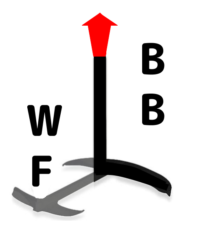Wing foilers that have even one friend that they ride with are all familiar with the usual conversation on the beach. “What wing are you using today?” is the usual starting point. Most riders have more than one wing to choose between and some of us have a full quiver of 4-5 wings of various sizes. As a small person at 52 kilos (115 lbs) I often reply “I’m on a 5, but I’m very small.” Sometimes I pro-offer my weight to clarify and as I coach, I might even add “For me a 5 is like a 7 or 8 for a bigger person.” So if the person I’m talking to is significantly bigger, and most of them are, the conversation isn’t as helpful as we might want.
For example, let’s say it’s a man that weighs 82 kilos (180 lbs). They are 158% of my weight, so if I’m flying a 5 and they want to rig a wing that is proportional to my weight, they would need a 7.9 meter. With a little math we are getting closer to being helpful, but what about the foil?
The people I usually ride with have more than one foil set and some of them have a full quiver of 3-4 front foils with tails that work with each. So many choices! My conversations on the beach are gradually starting to include this question, depending on who I’m talking to, but the resulting decisions about what to set up on a particular day are still largely a seat-of-the-pants process. So I’ve been day dreaming about a formulaic solution for a while.
I’ve started a more formal process of developing a Lift to Weight Ratio (“L”) formula that takes into account the most important factors. The goals for the formula are:
- Get a better feel for what to rig based on what your friends are using for equipment, even if their weight is much different from yours.
- A single number accounts for your foil size, wing size and weight.
- A larger number represents more power to get up on the foil, just like the wing sizes people are used to comparing.
- Easy to calculate. It’s probably not common for people to know how much their board weighs, so we’ll leave that out of the formula. If it’s too complicated, adoption would likely be too low to be helpful very often.
I’ve been playing with a simple formula that simply adds the wing to rider weight and foil to rider weight ratios together, with a constant multiplier for the wing calculation to account for the lower density of air than water and the use of meters vs centimeters for the two lifting surfaces. I’ve consulted with my friend John here on Cape Cod, who is an MIT educated expert of sorts in aerodynamics and hydrodynamics. He says the relationships I’m dealing with are non-linear and require calculus to properly represent. However he also says that if we get the constant right, even non-linear relationships can be linearized in the range of practical use needed. In other words, if I’m not mistaken, the important thing is to get the constant right and all we will have to use is simple math!
John and I believe that the size of foil and wing are roughly of equal importance to the ability to launch onto the foil. Thus, the contribution of each of these ratios to the final LWR number should be roughly equal, for the mean examples of wing and foil sizes often used together.
I’d like to gather more examples of what sizes of wing and foil riders prefer to use together for different wind speeds to verify the constant that seems to be emerging as best, while still being easy to work with on the beach! If you are willing to help, please use this google form. You can use it to provide as many equipment combinations that you have used, along with the typical minimum wind range you can use that set up.
Calculate Lift to Weight Ratio “L” potential with the beta 2 test phase formula
Enter the following information to calculate your wing foiling equipment’s lift to weight ratio by the following beta test formula: W/R * 500 + F/R:
OR
The combined lift to weight ratio, “L” potential is:


Leave a Reply